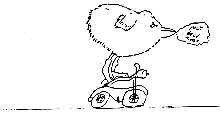 Back to Draw a Story
Back to Draw a StoryStimulus Examples
Summary of 12 responses using the stimulus drawing of the chick.
Copyright 1981/1982/1986/1989/1991 by Rawley Silver, reprinted with permission
from its original publication.
No portion of this work may be copied without written consent by Rawley Silver.
The following are excerpts from
Silver, R. A. (1991). Stimulus drawings and techniques in therapy, development, and assessment. Sarasota, FL: Ablin Press.
The Stimulus Drawings began as an attempt to communicate with deaf children who could neither lip-read nor speak. Since I did not know manual language, we were limited to gestures and pantomime until we discovered sketching. Then communication soared. The sketches which seemed to prompt the most expressive responses were used later on with learning disabled and emotionally disturbed children and adolescents, with adult stroke patients, and with unimpaired children and adults. Studies involving these individuals are discussed on page 82.
There were many surprises along the way. I had expected that the SDs would serve as symbols with essentially the same meaning for most respondents, that the SD chick, for example, would stand for something more than a young bird, perhaps a girl (the vernacular "chick") or someone vulnerable or weak.
Consider, however, the following responses by six children and six adults who chose the chick (Figure 1).
Figure 1. The Stimulus Drawing chick.

page 8.
Responses by Six Children Who Chose the SD Chick
Figure 2. "There was a little bird on the tight wire in the circus and the tight wire walker wanted to save it."
by Pete, age 8, who chose the chick and the ladder, associating them in a fantasy about the circus. His chick is insecure, teetering on the wire and in danger of falling. Although the tight wire walker wants to help, he has no hands or arms and is smaller than the "little bird."
To the extent that Pete identifies with his subjects, his response suggests that he feels as though he lives in a precarious world, like walking a tightrope. His response also reflects social attitudes - altruistic thoughts about rescuing or being rescued. Compare Pete's response with the response by Dave, Figure 3.
Figure 4: "You’re dead meat! A giant chick the king is afraid of the chick is running after the king" (dictated).
by Charlie*, age 8, who chose the chick and the motorcycle. associating them also with the king, mentioned in his title but absent from his drawing.
Unlike Pete and Dave, Charlie drew a menacing chick, aggressive rather than vulnerable, chasing and threatening a frightened king. This reversal of roles may be a wish-fulfilling fantasy in which Charlie identifies with the angry chick.

*Reproduced through the courtesy of Eileen McCormick, ATR.
Figure 11: "A Better Way."
by Ms D, a college student who chose the Parachutist in association with the chick. Her chick is resourceful and effective in spite of its strange environment. It has found a better way to reach its goal by hitching a ride on a parachute.

Figure 13:."Growling won't help you a bit. To me you're just another juicy worm"
by Mr. F, an elderly man. Like the chick represent who chose the chick and the dog. Like the chick represented by Charlie (Figure 4), Mr. F’s chick is menacing. It is much larger than the toothy dog, tied to a stake and likened to a worm (hen-pecked?).
Summary of 12 responses using the stimulus drawing of the chick.
These twelve responses to the drawing task suggest that the SDs serve as symbols with different meanings for different individuals. In only three of the twelve responses does the chick seem feminine (Figs 2, 3, 5) and in only six, does it seem weak or vulnerable (Figs. 2, 3. 8, 9, 10, 12). Two of the chicks are tough and aggressive (Figs. 4 and 13), and another, combined with the SD prince and whale, is categorized as "nice" (Fig. 7). Ten responses were fantasies reflecting negative or positive attitudes toward self or others, while two seem to represent thoughts, not feelings (Figs. 6 and 7).
To the extent that respondents identify the chick with themselves, they represent self-images: to the extent that they identify the chick with others, they represent social attitudes. Of the five female respondents, all seemed to identify the chick with themselves, two drawing pictures about chicks who are resourceful and effective (Figs. 5 and 13); three portraying chicks who are sad or forlorn (Figs. 8, 9,and 10). Of the seven male respondents, two seemed to identify with the chick (Figs. 4 and 12). Three drew chicks that appear neither masculine nor feminine (Figs. 2, 6, and 7). Two drew chicks that appear both feminine and disliked, one became large and menacing (Fig. 13), the other, without feathers, became an unattractive victim of assault.
These responses suggest that different individuals perceive the same SDs differently, providing access to fantasies and opportunities for discussion.
page 21.